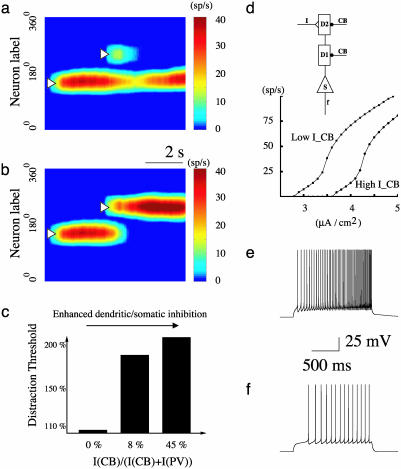Fig. 6.
Robustness against distracting stimuli is enhanced by an increased ratio of the dendritic/somatic inhibition. (a and b) Simulation protocol. A transient cue (0.8 μA/cm2, 250 ms) elicits a spatially localized persistent activity pattern, which is resistant (a) to a weak distractor (1.125 μA/cm2, 250 ms) but not (b) when the distractor (2.25 μA/cm2), is stronger than a distraction threshold. ICB/(ICB + IPV) is 8%. (c) Increased resistance against distractors with a larger dendritic/somatic inhibition ratio (ICB/(ICB + IPV)). (d) Input–output relation for an isolated P neuron, in response to current inputs to distal dendrite and in the presence of dendritic inhibition mediated by CB interneurons. The amount of inhibition from CB neurons was estimated from the network simulation, when the remembered stimulus is opposite from the preferred cue of the cell, either for the resting state (upper curve) (–0.529μA/cm2 to both dendritic compartments, d1 and d2) or the delay period (lower curve) (–0.845 μA/cm2). Two examples with the same input current intensity but two different levels of dendritic inhibition are shown in e and f. The P cell's responsiveness is greatly reduced during the delay period because of enhanced dendritic inhibition, which provides a mechanism for filtering out distractor stimuli.

